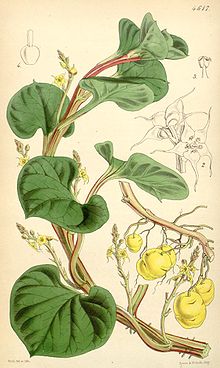| Ullucus | |
|---|---|

| |
| Scientific classification | |
| Kingdom: | Plantae |
| Clade: | Tracheophytes |
| Clade: | Angiosperms |
| Clade: | Eudicots |
| Order: | Caryophyllales |
| Family: | Basellaceae |
| Genus: | Ullucus Caldas |
| Species: | U. tuberosus
|
| Binomial name | |
| Ullucus tuberosus Caldas
| |
| Synonyms | |
| |
Ullucus is a genus of flowering plants in the family Basellaceae, with one species, Ullucus tuberosus, a plant grown primarily as a root vegetable, secondarily as a leaf vegetable. The name ulluco is derived from the Quechua word ulluku, but depending on the region, it has many different names. These include illaco (in Aymara), melloco (in Ecuador), chungua or ruba (in Colombia), olluco or papa lisa (in Bolivia and Peru), or ulluma (in Argentina).[1][2]
Ulluco is one of the most widely grown and economically important root crops in the Andean region of South America, second only to the potato.[3] The tuber is the primary edible part, but the leaf is also used and is similar to spinach.[4] They are known to contain high levels of protein, calcium, and carotene. Ulluco was used by the Incas prior to the arrival of Europeans in South America.[5] The scrambling herbaceous plant grows up to 50 cm (20 in) high and forms starchy tubers below ground. These tubers are typically smooth and can be spherical or elongated. Generally they are a similar in size to the potato; however, they have been known to grow up to 15 cm (5.9 in) long. Due to the brightly coloured waxy skin in a variety of yellows, pinks and purples, ullucus tubers are regarded as one of the most striking foods in the Andean markets.[6]
Ullucus tuberosus has a subspecies, Ullucus tuberosus subsp. aborigineus, which is considered a wild type. While the domesticated varieties are generally erect and have a diploid genome, the subspecies is generally a trailing vine and has a triploid genome.[7]
- ^ Busch, J. and Savage, G.P. (2000). Nutritional composition of ulluco (Ullucus tuberosus) tubers. Proceedings on the Nutrition Society of New Zealand, 25 pp. 55-65.
- ^ Arbizu, C., Huamán, Z. and Golmirzaie, A. (1997). ‘Other Andean Roots and Tubers’ in Fuccillo, D., Sears, L. and Stapleton, P. (1st ed.) Biodiversity in Trust: Conservation and Use of Plant Genetic Resources in CGIAR Centres. Cambridge: Cambridge University Press pp.39-56.
- ^ Hermann, M. and Heller, J. (1997). Andean roots and tubers: Ahipa, arracacha, maca and yacon. International Plant Genetic Resources Institute, Rome, Italy.
- ^ National Research Council (1989). Lost Crops of the Incas: Little-known Plants of the Andes with Promise for Worldwide Cultivation. National Academic Press.
- ^ Hernández Bermejo, J. E. and León, J. (1994). Neglected crops: 1492 from a different perspective. Roma: FAO
- ^ Scheffer, J.J.C., Douglas, J.A., Martin, R.J., Triggs, C.M., Hallow, S. and Deo, B. (2002). Agronomic requirements of ulluco (Ullucus tuberosus) – a South American tuber. Agronomy N.Z. 33, pp 41- 47.
- ^ Cite error: The named reference
:0was invoked but never defined (see the help page).